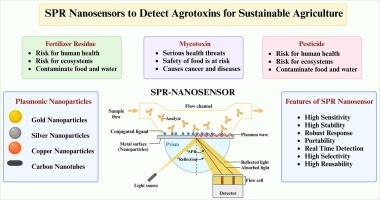用于检测农业毒素的高灵敏度等离子纳米材料传感器的最新进展:当前进展与未来展望
IF 7.7
1区 农林科学
Q1 AGRICULTURE, MULTIDISCIPLINARY
引用次数: 0
摘要
农用化学品残留物和霉菌毒素等农用毒素会污染环境,并对人类生活和生态系统产生潜在的不利影响。过度使用农药和化肥等农用化学品可能会提高作物产量,但却会导致有毒残留物在农场中积累。同时,田间出现的各种与真菌相关的毒素也会对人类健康产生不利影响。目前,可用于监测这些有害物质的方法很少,因此开发一种能够高效、快速、现场检测和量化环境中农业毒素残留的传感器势在必行。利用纳米技术设计传感器是检测和定量环境中农业毒素残留的一种推荐方法。增强型表面等离子体共振(SPR)传感器已被开发出来,并作为有用的工具用于检测各个领域中难以检测的化合物。因此,基于 SPR 的纳米传感器将是检测农业毒素残留的一种有前途的方法,因为它们易于使用、无需标记、微型化、特异性强、灵敏度高,而且具有实时测量功能。然而,目前在设计 SPR 纳米传感器以检测土壤中的农业毒素残留方面,还存在着文献空白,也缺乏对纳米微生物最新研究进展的全面综述。本综述旨在概述用于检测农业毒素的 SPR 纳米传感器的 NMs。该综述还讨论了与农业毒素检测相关的挑战以及为此目的使用纳米传感器的未来前景。本文章由计算机程序翻译,如有差异,请以英文原文为准。

Recent advances on highly sensitive plasmonic nanomaterial enabled sensors for the detection of agrotoxins: Current progress and future perspective
Agrotoxins, such as agrochemical residues and mycotoxins, pollute the environment and have potentially adverse effects on human life and ecosystem. Excessive use of agrochemicals such as pesticides and fertilizers may increase crop production, however, leads to toxic residue accumulation on farms. Concomitantly, the emergence of various fungus-associated toxins in fields can have adverse effects on human health. Currently, there are few methods available for monitoring these harmful substances, making it imperative to develop a sensor that can detect and quantify agrotoxin residues in the environment efficiently, rapidly, and on-site. Designing sensors based on nanotechnology approaches is a recommended approach for detect and quantify agrotoxin residues in the environment. NMs enhanced surface plasmon resonance (SPR) sensors have been developed and employed as useful tools to sense difficult-to-detect compounds in various fields. Therefore, nanosensors based on SPR will be a promising approach to detect agrotoxin residues because they are easy to use, don’t require labelling, are miniaturized, have high specificity and sensitivity, and are available with real-time measurement capabilities. However, currently, there is a gap in the literature and a lack of comprehensive reviews on recent advances in NMs for the design of SPR nanosensors to detect of agrotoxin residues in soil. The objective of this review is to provide an overview of NMs for SPR nanosensors used in detecting agrotoxins. The review also discusses the challenges associated with agrotoxin detection and the future prospects of using nanosensors for this purpose.
求助全文
通过发布文献求助,成功后即可免费获取论文全文。
去求助
来源期刊

Computers and Electronics in Agriculture
工程技术-计算机:跨学科应用
CiteScore
15.30
自引率
14.50%
发文量
800
审稿时长
62 days
期刊介绍:
Computers and Electronics in Agriculture provides international coverage of advancements in computer hardware, software, electronic instrumentation, and control systems applied to agricultural challenges. Encompassing agronomy, horticulture, forestry, aquaculture, and animal farming, the journal publishes original papers, reviews, and applications notes. It explores the use of computers and electronics in plant or animal agricultural production, covering topics like agricultural soils, water, pests, controlled environments, and waste. The scope extends to on-farm post-harvest operations and relevant technologies, including artificial intelligence, sensors, machine vision, robotics, networking, and simulation modeling. Its companion journal, Smart Agricultural Technology, continues the focus on smart applications in production agriculture.
 求助内容:
求助内容: 应助结果提醒方式:
应助结果提醒方式:


